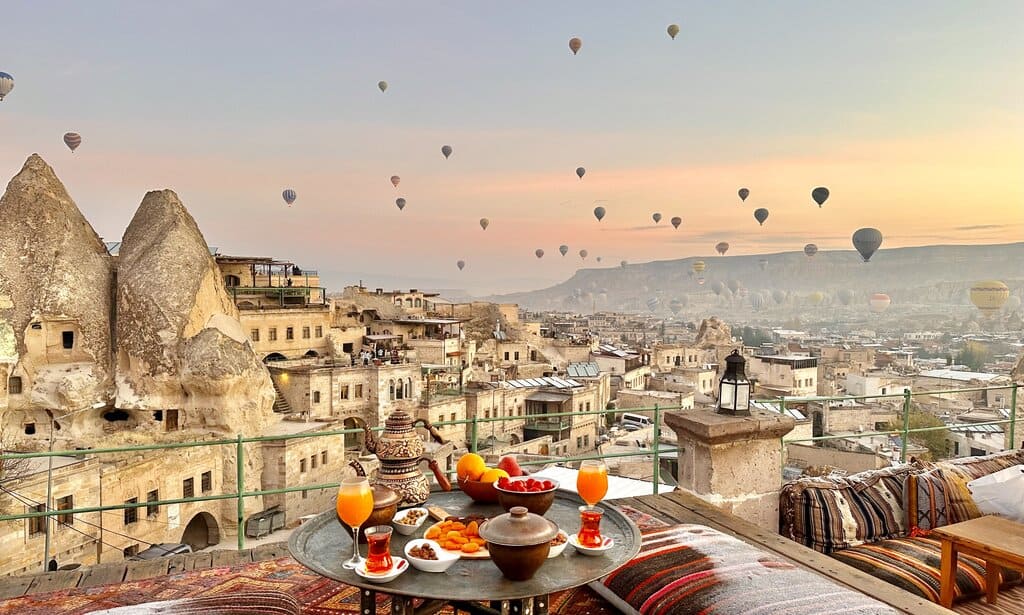Are you considering visiting Cappadocia in winter? While Cappadocia is most popular in the spring and summer, wintertime offers many advantages to the traveler who doesn’t mind being a bit cold.
You’ve surely seen the pictures on social media. The beautiful woman in the long flowing dress gazing out on hundreds of hot air balloons as they fly over old stone buildings and unique rock formations. Cappadocia is simply stunning, and it’s one of the most sought out tourist destinations in the world.
But with popularity comes overcrowding. The best way to avoid claustrophobia in Cappadocia is to visit in the low season. This post discusses all the advantages of visiting Cappadocia in winter and the off season.
Note: this article contains affiliate links, which means that should you purchase something or get a quote through them I may make a small commission at no additional cost to you. This helps keep the site running with up to date information. I do not represent World Nomads, Booking.com, GetYourGuide, Viator, or Rentalcars.com. This is information only and not a recommendation to buy the product mentioned in this article.
Cappadocia in Winter – What You Need to Know
What exactly is Cappadocia?
Cappadocia is a region of central Turkey known for ancient cave dwellings. For hundreds of years the region’s natives lived in cave homes dug into cliffs and unique cone-shaped rocks. Some of the cave dwellings are thought to be over 2000 years old, though most are believed to be dug during the Middle Ages, as varying conquerors swept the region.
These days, however, Cappadocia is known more for the unique spectacle of hundreds of hot air balloons flying over the Goreme Valley every morning. Combined with the ancient cave dwellings, it makes Cappadocia a truly magical place.

Where is Cappadocia?
Cappadocia is almost in the geographical center of Turkey. There is no official border of the Cappadocia region, but it covers a vast area of dry, barren land south of the city of Avanos.
That being said, when you hear someone say Cappadocia they are typically talking about the area within about a five mile radius of the town of Goreme. Goreme is where the hot air balloons fly over and is the main landmark of the region.
How to get to Cappadocia
There are two airports that serve the Cappadocia region, neither of which has long-haul flights. The closest is Nevsehir Cappadocia Airport, which is northwest of Goreme, about a 45 minute drive. There are a couple daily flights to Istanbul from the airport and literally nothing else.
The other airport is in the city of Kayseri, about a 1 hour drive east of Goreme. There are more flights to Kayseri as it’s an actual city, including numerous seasonal flights to places like Amsterdam, Brussels and Frankfurt. Rental cars tend to be cheaper from there too.
Kayseri itself can only be described as the most Soviet Russia looking city ever, even though it was never part of the Soviet Union. Don’t spend any more time there than you need to.
You can find a great deal on a rental car in Turkey with Rentalcars.com using this link or using the search bar below.
We flew to Kayseri because the flight times from Istanbul were more favorable. Either way, you’ll either need to rent a car or book a transfer to Goreme (or whatever town you are staying in). Hotels will usually book transfers for you, but they will not be cheap unless you do a shared ride. You can take a taxi, but in my experience it’s worth a bit extra to rent your own car.
You can also fly into Ankara, the capital of Turkey, if you don’t mind a 3 hour drive. Unfortunately there are no decent public transportation options to get to Cappadocia.
The nearest train station is in Kayseri. There is a bus terminal in Nevsehir though, should you wish to make the long bus journey across Turkey. If you have a limited budget, public transport is an option, just know it will take you a while to get there.
How to get around Cappadocia
My firm recommendation is to rent a car. Driving in Turkey is similar to Europe and safe. A vehicle gives you the freedom to choose your own adventure. That being said, taxis are plentiful and affordable. They just might not be where you want them to be at any given time.
It’s also possible to just walk to almost all the main sites if you don’t mind hiking and covering 10-15 miles in one day. This would really limit the things you can see, though.
In December 2022 we paid 94 euros for a 4 day rental car with Bera Car Rental from the Kayseri airport. It’s worth it for the freedom of your own wheels even if you’re on a tight budget!
Should you not want to drive though, there are literally dozens of tour companies that will happily take you on one of their incredibly popular day tours. These tours are known simply as the “red tour”, the “blue tour” and the “green tour” and they all have different itineraries that take you well outside Goreme.
Your hotel will pitch them to you when you check in, so I won’t go into detail here.
Winter Weather in Cappadocia
See the entire section below on winter weather in Cappadocia. In short, it’s unpredictable.
Where to stay in Cappadocia
Cappadocia has more beautiful cave hotels than you can shake a stick at. Numerous hotels are built on what are known as fairy chimneys. These are large steep cone-shaped rocks.
Staying in a cozy room built into a rock is an experience to treasure. They are not cheap though, even in the winter, so there are plenty of other more affordable options that are more like normal hotel rooms in normal buildings.
Of all the villages in Cappadocia the two most beautiful and iconic are Goreme and Uchisar, just up the road. The majority of cave hotels are in these two towns. If you can afford it, it’s highly recommended to experience staying in a fairy chimney room at a cave hotel.
We stayed at Kelebek Cave Hotel and can’t recommend it more. The property is stunning and has an amazing view of Goreme. The service is excellent, the restaurant is top notch, and the fairy chimney suites are magical.
Their sister property Sultan Cave Suites is also very highly regarded and about a 30 second walk away from Kelebek. Another top rated option is Mithra Cave Hotel, just down the block.
Where to stay in Cappadocia
- Kelebek Cave Hotel
- Sultan Cave Suites
- Mithra Cave Hotel
- Budget option: Grant Elite Cave Suite (less than $100/night, still really nice place)
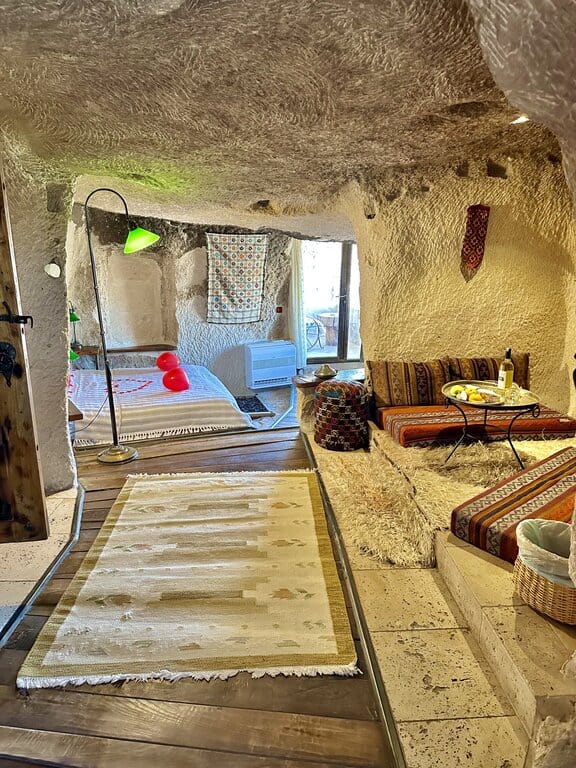
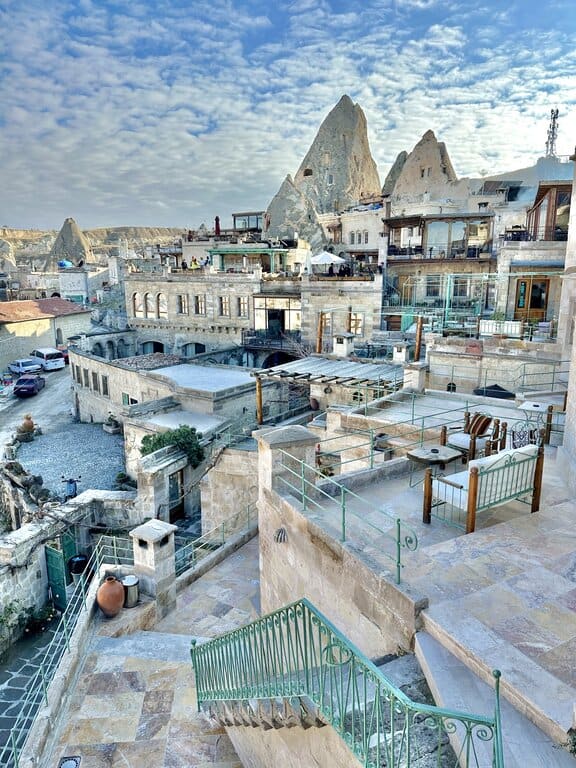
How long to stay
You will want an absolute minimum of two nights in Cappadocia, but ideally three or four. While it’s possible to explore the region in two days, the hot air balloons don’t take off when the weather isn’t favorable. You didn’t come all this way to miss the hot air balloons did you?
Three days gives you a pretty solid assurance you’ll see the balloons at least one day. We spent three nights in Goreme and the balloons flew two of the mornings. The third day they were canceled due to fog, but it’s more common for high winds to cause cancellation. Winters are windier than summers so keep that in mind.
Language
Cappadocia is one of the most tourist infested places on earth, so everyone in the service industry speaks at least some level of English. Many also speak some Spanish as well. Outside of the tourist spots, though, expect the locals to only be able to communicate in Turkish.
Money
Turkey has their own currency, the Turkish Lira. It’s still very much a cash dominated society so you will want to carry cash at all times. Tipping is not customary but appreciated.
Whether or not Cappadocia is expensive or not really depends on where you come from. A full discussion of the downfall of the Turkish Lira would take ages but let’s try to cover the basics.
Inflation in Turkey since the Covid pandemic is out of control. Like, it was 100% at the end of 2022. So everything literally doubled in price in one year.
At the same time, the Lira has become increasingly devalued against major global currencies. When I first visited Turkey in early 2018 $1 USD was equal to 3.75 Lira. In December 2022 it was 18.5. As of October 2023, $1 is not 27 Lira .You can do the math. It’s flat out bonkers.
PTO TIP: for getting Turkish Lira, it’s best to bring dollars or your own currency and exchange them at one of the many currency exchanges across Turkey. These are usually located on main downtown streets. ATMs in Turkey charge an exorbitant 8% fee for taking out money with a non-European bank card, while the currency exchanges give just about the market rate.
Nice hotels in Cappadocia are usually about 80-100 euros per night for a standard room and 150-200 for a suite in the winter low season. In summer, they’re 2-3x that price.
For comparison, the average Turkish professional in Istanbul makes less than 1000 euros per month. So essentially Cappadocia is ridiculously expensive for Turks, but very affordable for Americans and other nationalities that can benefit from the exchange rate.
Food and Restaurants
Cappadocia has some amazing restaurants and some of its own local cuisine. Some things to be sure to try when you’re there:
- Manti (little Turkish meat raviolis)
- Pottery kebab (basically lamb or another meat cooked in a clay pot with vegetables)
- Sukuk (Turkish sausage)
Some of the best restaurants to be sure to try are listed below. Dinner for two with a bottle of wine will cost at least $50.
- Seten at Sultan Cave Suites in Goreme
- Topdeck Cave Restaurant
- Inci Cave Restaurant
- Lil’a Restaurant
And many more! Or if you’re looking for something a bit cheaper there are plenty of doner shops around town where you can get a delicious durum wrap for $2.
Fairy Chimneys
This is a term you will read a lot about when researching Cappadocia so let’s make sure you know what it is. A fairy chimney is a conical or cylindrical shaped rock that sticks out of the earth on its own. Some examples are shown in the photos below.
They can be wide or narrow, tall or short. Many cave dwellings have been built into fairy chimneys and these days you can stay in one as many nice hotels have built rooms within the rocks. It is highly recommended to stay in a fairy chimney suite if it’s in your budget.
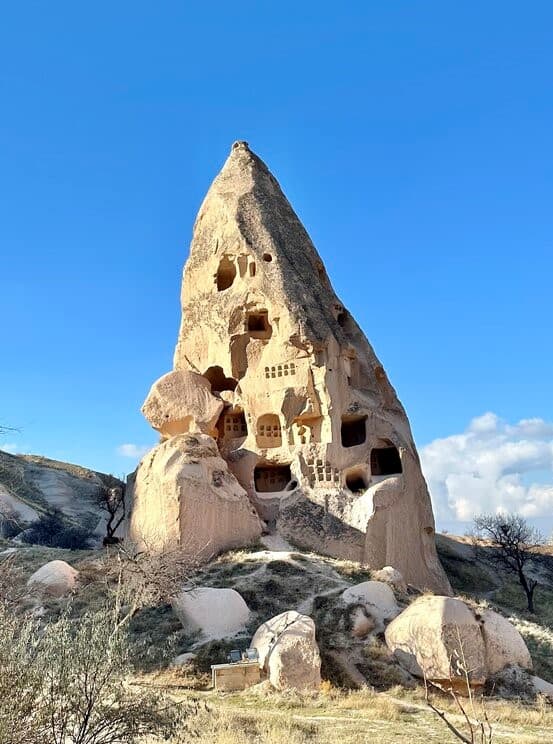

Cappadocia Hot air balloons
Hot air balloons are probably more associated with Cappadocia than any other place on earth. Every morning dozens – and sometimes hundreds – of hot air balloons fly across the early morning sky, creating that famous view you’re going to Cappadocia to see.
Booking a ride in a hot air balloon is not difficult and only needs to be done about a day in advance. It’s best to not book too far ahead of time so you can see the weather forecast. Your hotel will be able to arrange the booking for you, or you can pre-book with Viator or GetYourGuide.
The ride takes about one hour and will cost you at least 180 euros per person. The smaller the balloon’s cab, the more you’ll pay. Full disclosure: we didn’t do the balloon ride. We were most excited about seeing the balloons from the viewpoints.
There’s a full section below on the best spots in Cappadocia to see the balloons take off and land. But for a detailed description check out my entire post of the best places in Cappadocia to see the hot air balloons.
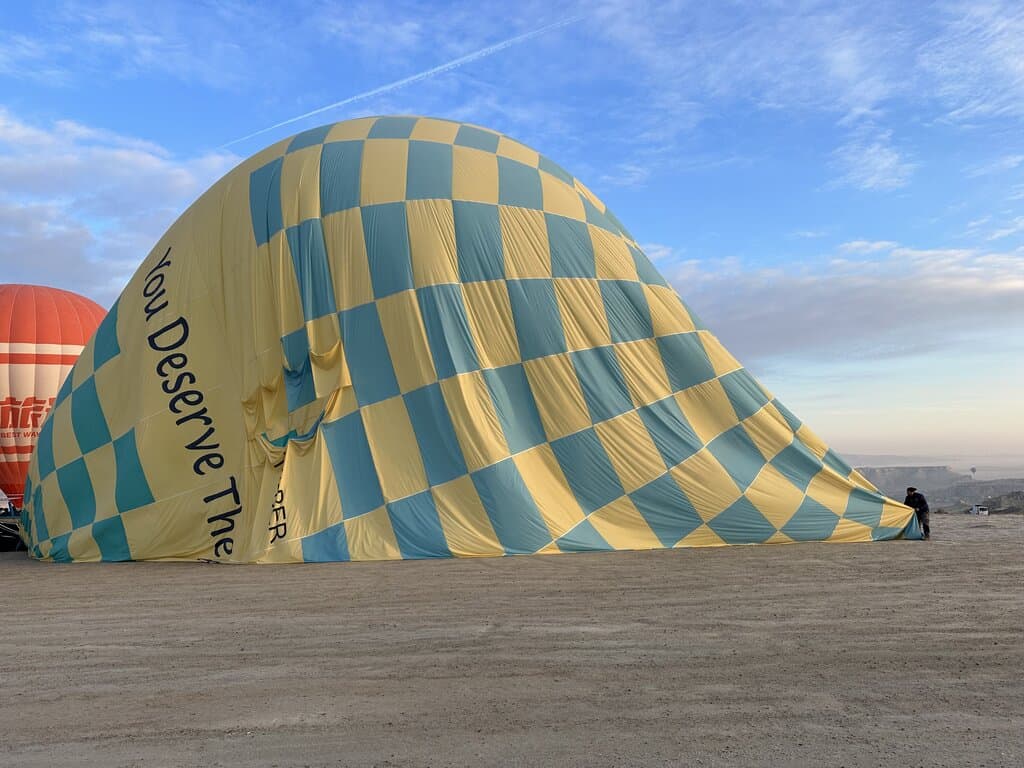
Stray cats and dogs
There are stray cats and dogs all over Cappadocia so just be aware. They are all incredibly friendly and just looking for food. Mini markets all sell cat and dog food should you wish to feed them.
Travel insurance
It’s a good idea to have travel insurance in TUrkey so that you’re protected for the unexpected. We use World Nomads when we travel internationally. World Nomads provides coverage to travelers in over 100 countries. You can search for a coverage plan using the link below.
5 Reasons to Visit Cappadocia in Winter
Visiting Cappadocia in the winter isn’t for everyone, but for those willing to brave the frigid mornings, a winter visit offers many benefits. We will go through all of those benefits in this section.
1) Avoid the crowds
By far the number one advantage of a winter trip to Cappadocia is avoiding the massive crowds that swarm the region in the summer. As one of the most popular tourist destinations on earth, Cappadocia can get downright busy. Hotels and restaurants book out, and you’ll be shoulder to shoulder with other visitors trying to get your photos of the balloons over Goreme valley.
Fall and Spring are not nearly as busy as summer, but still get a lot of visitors due to the pleasant weather. If you really want to feel like you have your space though, winter is the time to go.
Popular viewpoints have people but aren’t busy, you don’t need reservations to get a nice dinner out, but there are enough people so that the towns are not totally dead and the balloon flights still sell out. So if you’re worried about there not being enough balloons in flight in winter, don’t. There will still be 100 or so balloons each day.
Winter in Cappadocia is not empty at all, but pleasantly populated. There are enough people around to exchange stories with other travelers and discuss the best places to see the balloons. You just won’t have to deal with massive tour buses and waiting in line for the popular photo spot. The amount of people is really perfect in the winter!
2) Save significant money on accommodation
Another major benefit of visiting Cappadocia in winter is that the prices for the beautiful cave hotels are typically less than half what they sell for in the summer. They’re still not dirt cheap by any stretch of the imagination, but for what you get you’ll be extremely satisfied.
We paid 180 euros per night for a fairy chimney suite at Kelebek Cave Hotel, one of the best hotels in Goreme. We literally stayed inside an exquisitely decorated cave. Good luck getting that price in the summer!
3) Hiking without heat exhaustion
Cappadocia is a hikers paradise. With winding trails through the valleys and ridges everywhere you can imagine, getting out on the trails is one of the top things to do in Cappadocia. And while winter temperatures might scare you, with a warming planet winter daytime highs are actually not so bad these days.
The average January high is historically about 39 degrees (4 C), but in 2023 was in the 50s every day (10 C). That being said, February brought frigid temperatures to the region that would make hiking a bit difficult.
The cool temperatures mean that you can pretty much walk all day up and down hills without getting too tired and sweaty. Since it’s an arid region it’s usually sunny, which keeps you warmer on the colder days. Refer to the section at the end of this post on Cappadocia hikes for a breakdown of the best walking trails in the region.

4) Everything is still open in the winter
Unlike winter in Santorini, everything is open in Cappadocia in winter. Hotels and restaurants don’t seasonally close like many Mediterranean destinations. Shops are still open and taxis are still around. Balloons still fly and daily tours still operate.
You won’t see too many massive tour buses (you’ll still see some), but day tours of the popular spots outside of Goreme are still popular in the winter. The only real difference in terms of what’s open is that many places won’t staff outdoor areas unless it’s an unseasonably warm day.
5) You might get lucky and see it covered in snow

When visiting Cappadocia in the winter you always have the possibility of getting snow. Snow can fall as early as November and as late as early April, though it’s unlikely to stick on the ground in November and April. While being there during an actual blizzard might ruin your day, seeing the Cappadocian landscapes covered in snow is a sight to behold.
It actually snows quite a bit in Cappadocia, so if you’re visiting in winter you have to be prepared for the possibility of snow. The winter of 2022-2023 was quite rare in how little snow fell (perhaps a sign of what’s to come with climate change?)
Cappadocia Winter Weather
This is probably what you are most worried about. Maybe you’ve heard stories of people freezing their butts off watching the balloons takeoff at 7 in the morning.
The region is about 3600 ft (1100m) above sea level and it’s far from the coast so that keeps the temperatures a bit lower than Istanbul. But don’t worry, it’s not too bad and it’s not like you’ll be standing still outside all day. Let’s break it down by average temperatures from November to March in Goreme.
- November: 52 high to 30 low (11 to -1 C)
- December: 43 high to 25 low (6 to -4 C)
- January: 39 high to 20 low (4 to -6 C)
- February: 43 high to 22 low (6 to -5 C)
- March: 51 high to 28 low (10 to -2 C)
When we went in early December each morning was just below freezing and the days were pleasantly warm, in the low 50s. I got warm enough hiking to go shorts and a t-shirt. A friend went a month later in January and had the same weather.
But when a cold front came through a few weeks later, temps stayed below freezing for multiple days in a row through most of February. Then at the end of February it was in the 60s. Either way, so long as you’re prepared for the temperatures you will have a good time.
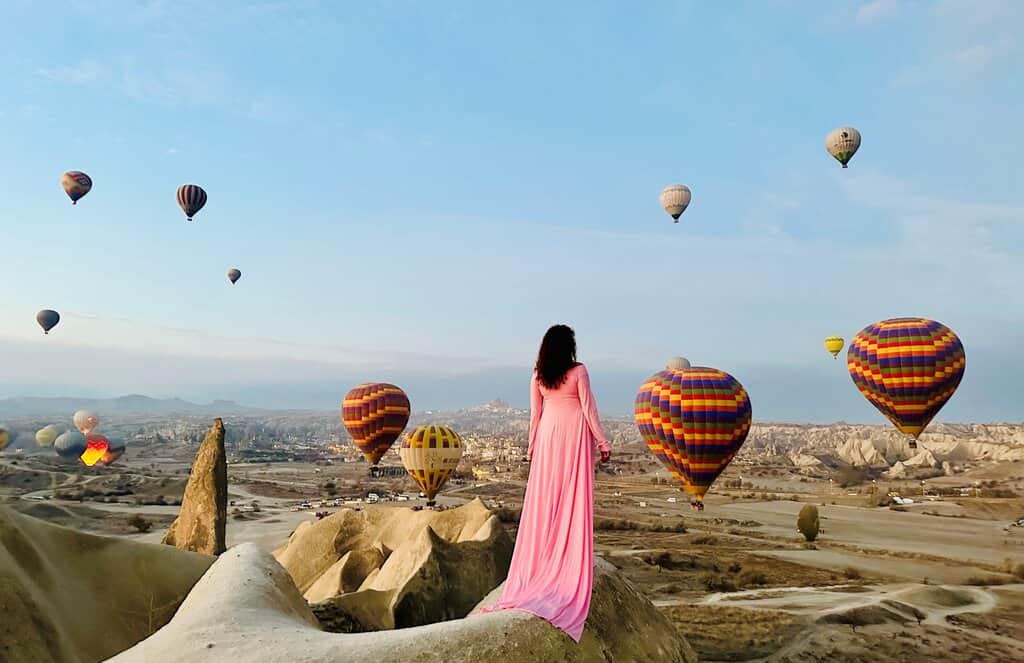
Balloon watching
The balloons takeoff at sunrise, and this is usually the coldest time of the day. As you need to be outdoors to see them, this means that you’ll have to be outside at the coldest hour. And sure, it can be pretty damn cold. If a cold front comes through it can be downright polar.
But most winter mornings in recent years are right around freezing or a few degrees below. Come prepared with a good jacket and a nice pair of touch screen gloves and you’ll hardly think about the weather.
Winter does get more cloudy days than summer, and it is possible that you’ll have completely overcast skies. But that’s a risk you take traveling anywhere at any time. Rain is not that common due to the high plateau desert climate. April is actually the rainiest month in Cappadocia.
The Drawbacks of Cappadocia in Winter
Naturally, the possibility of freezing cold temperatures is a natural deterrent to a winter visit to Cappadocia. You might feel like you’re missing out by not being able to sit outside on the terrace for lunch and dinner.
Besides hiking and exploring the cave cities – activities that involve moving around – there isn’t much else you can do outside unless you get a particularly warm day (which is very possible by the way). We were able to enjoy one outdoor lunch in the sun, but you shouldn’t count on it.
Another downside of winter is that the mornings are on average windier than summer. That can be said about the entire planet, but as we discussed earlier, if it’s too windy the balloons cannot fly. I can only imagine how disappointing it would be to have multiple windy days in a row and not be able to see the balloons fly across the valley.
Other than those weather-related downsides, there isn’t much else other than the amount of daylight. You simply don’t have as much time between sunrise and sunset in the fall and winter. If that’s your main concern though, consider a visit in March, when the days are starting to get longer.
The Layout of Cappadocia
Cappadocia can be broken down into a few main towns and the roads between them. The map below shows the towns as well as all of the main points of interest in the region. The points of interest are discussed in the next section.
Goreme
The unofficial capital of Cappadocia is Goreme. It’s a small town of about 2000 residents and thousands more tourists at any given time.
Situated in the heart of Cappadocia, it’s the town the balloons fly over and thus the most visited in the region. It has a small downtown with numerous shops and restaurants and even more tour agency offices. Fairy chimneys are scattered throughout the town.
The majority of buildings outside the city center are hotels and guesthouses. Most of Cappadocia’s famous cave hotels are found in Goreme. Just outside the town there are numerous historical sites like Goreme Open Air Museum, Zelve Open Air Museum, Love Valley, Pigeon Valley, and more. We will go into detail on each location in the next section.
If you want to stay where the action is, you’ll want to book a place in Goreme.
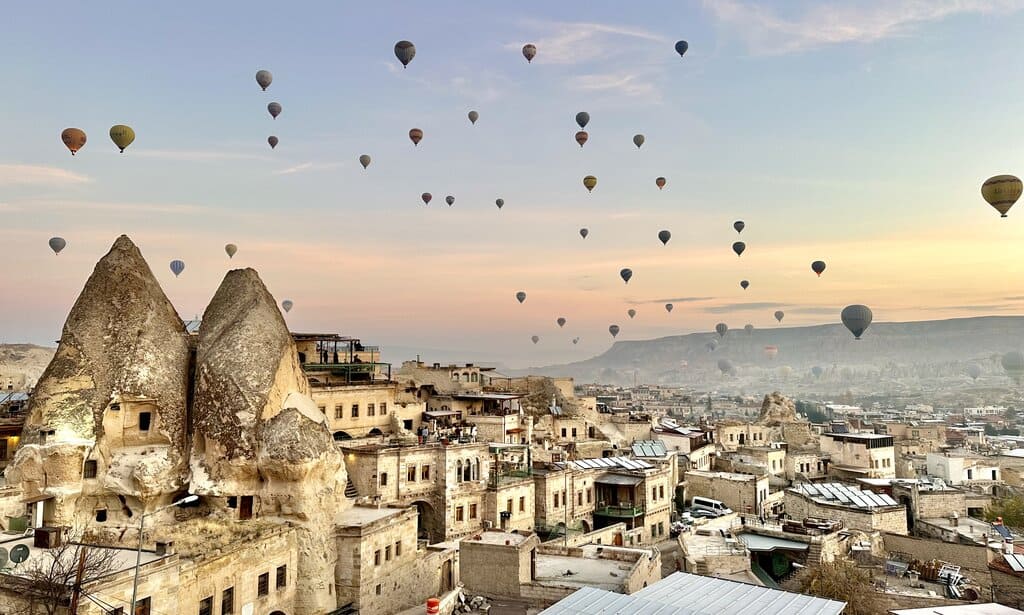
Uchisar
Perhaps the most posh of the Cappadocia towns, Uchisar sits on a hill about three miles southwest of Goreme. Its tourist district is smaller than Goreme, but the town stretches a bit further out, with more residential neighborhoods as more locals live there. The accommodations on the side of the hill that faces Goreme tend to be more on the luxurious side, while the hotels on the other side of the hill are more affordable since you can’t see the balloons over Goreme.
The key landmark of Uchisar is Uchisar Castle. Now, while it’s called “castle”, it’s not what you’re thinking. It’s a giant rock that protrudes from the top of the hill and had passageways and rooms carved into it hundreds of years ago to make an underground city.
The castle is the center of the town and various other rock formations dot the landscape as you come down the hill. There is a path from Uchisar to Goreme that runs a little over two miles and takes you through a funky valley of rocks and cave dwellings known as Pigeon Valley.
Ortahisar
The town of Ortahisar completes a little triangle of magical Cappadocian villages. It’s about 3 miles southeast of Goreme and like Uchisar, features a “castle” atop a hill in the city center. Ortahisar Castle sits 86 meters above the rest of Ortahisar below and offers great views of Goreme and the historical sites between.
Like its neighbors, Ortahisar is full of restaurants and cave hotels. If the cave hotels in Goreme and Uchisar are a little out of your budget you’ll likely find something agreeable in Ortahisar.
Urgup
Flanking the eastern boundary of Cappadocia is Urgup. With a population of 20,000 it’s considerably larger than its neighboring towns. But it too has a wide range of cave hotels and fairy chimneys.
Urgup is known for its wine production. Turason is the largest wine producer in Cappadocia and has its main wine store and tasting house in the town. If you don’t make it there, however, Turason wine is literally everywhere in Cappadocia and if you are offered wine it’s most likely theirs.
Nevsehir
Nevsehir is the main city in Cappadocia, home to about 80,000 people. While it’s not nearly as touristy as the towns discussed above, it does have a few cave hotels of its own if you’re looking to save some money.
Many of the hospitality workers in Cappadocia live in Nevsehir, so if you’re looking to eat where the locals eat, consider a meal in the city. Other than that, there aren’t a whole lot of reasons to spend your limited time in Nevsehir.
Avanos
Avanos is another town where hospitality workers live. It’s not really a place you’ll be stopping in but you’ll probably drive through it at some point since it’s about 5 miles north of Goreme and on the way to Kayseri. It’s most known for pottery production – you will see A TON of clay pottery around Cappadocia – and does not have the same landscape of fairy chimneys like the tourist towns described above.
Kaymakli and Derinkuyu
Kaymakli and Derinkuyu are two small towns on the southern end of Cappadocia that are known for having two of the most impressive underground cities in the world. Other than that the towns are actually really depressing. More on the underground cities later.
The 7 Best Things to do in Cappadocia in Winter
So now that you’ve come to Cappadocia in the winter, what should you do to spend your day? Let’s go through the top things to do in Cappadocia.
1) See the balloons takeoff
I have a full detailed post on all the best spots in Cappadocia to see the balloons take off and land.
But as a quick breakdown let’s list them out here too:
Sultan Cave Suites
The most famous spot for getting balloon views in Goreme. The city photos on this page are taken from here. Note that in winter pretty much anyone can come take photos here, but in summer only guests of Sultan and its sister properties Kelebeck, Aza and Seki can use their terrace.
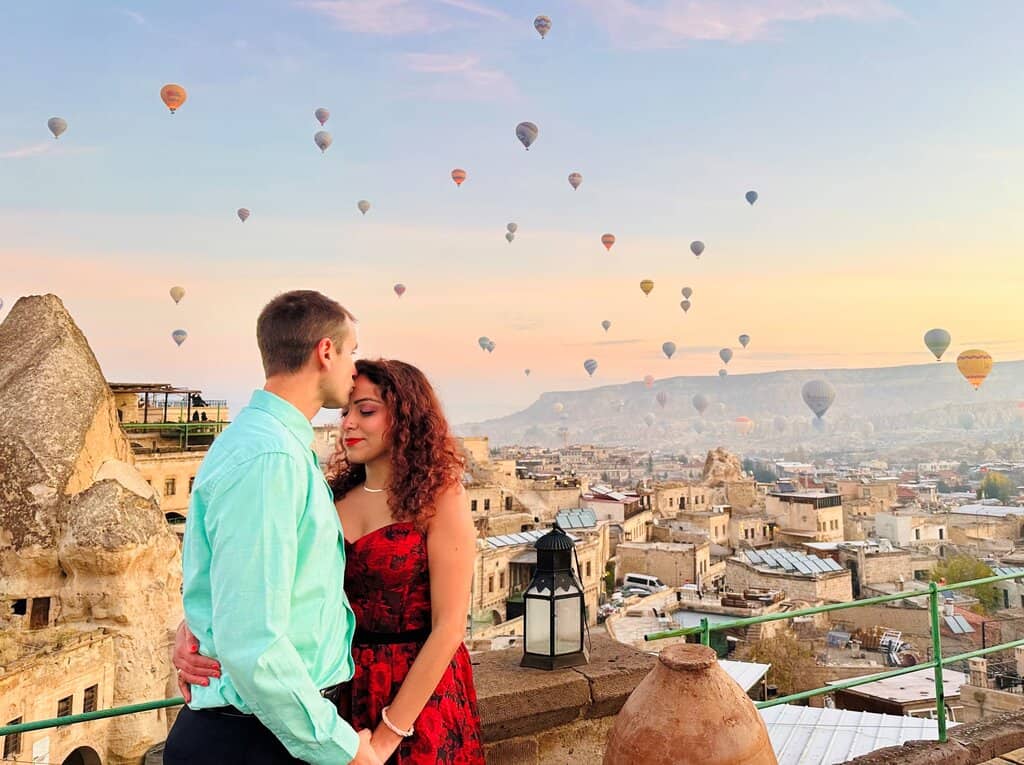
Mithra Cave Hotel and Koza Cave Hotel
These two hotels are right next to each other and a stone’s throw from Sultan, so similar views. Most hotels have some sort of terrace as well, but these are the best alternatives.
Sunrise viewpoint Goreme
This is a large hill right at the edge of the city. Open to the public.
The hill at Red Valley ATV
This is a spot where ATV tours start but it’s also the exact same spot that most of the balloons take off. You’re literally right in the thick of the balloons here.
Love Valley Panoramic View
This view looks into the sun and you’ll see the balloons sore over Goreme and land right in front of you, as most land near the viewpoint.
The dirt road behind Goreme Panoramic Camping
Just up the hill from Goreme past the campsite there is a dirt road that leads to a dead end at a steep cliff. Many balloons land around here too.
Red Valley Panorama Viewpoint
This site looks west, so the sun is behind you. The balloons take off in front of you and head further west.
Museum Hotel in Uchisar
For a more distant view of the balloons over Goreme and Pigeon Valley, consider the Museum Hotel in Uchisar (or one of its neighbors)
2) Ride in a balloon yourself
While the most famous views of Cappadocia are from the ground, being in the air gives you a unique vantage point over this fascinating region. Not everyone takes a hot air balloon ride, but it’s a very popular thing to do in Cappadocia. Balloon rides start at about 180 euros per person.
There are countless companies that provide balloon rides. Typically you will book the tour through your hotel but you can also book early if you wish. You can check out all the Cappadocia balloon tours on GetYourGuide here, or using the banner below. The only thing about booking too far in advance is you don’t know the weather forecast.
The operator will pick you up in your hotel well before sunset and take you to the balloon takeoff site. Here you’re given a light breakfast and prepared for the ride. The ride itself is about an hour and landing is usually celebrated with a champagne toast after landing. After the service you’ll be dropped back at your hotel.
3) Visit ancient sites and cave cities
Take away the hot air balloons and Cappadocia is still an incredible place. The rocks in the region are soft. They’re made of tuff, which is basically volcanic ash. You can scrape them off with your fingers. This meant it was easy for people thousands of years ago to carve into the rocks. People in Cappadocia lived in caves carved into this soft tuff rock until the 20th century.
There are ancient caves all over Cappadocia. Some of the larger ones are discussed here. This is by no means an exhaustive list, but these are the main sights and the places you will want to focus on for beauty and historical significance.
Goreme Open Air Museum
The Goreme Open Air Museum is an enclosed area that protects many ancient cave dwellings and churches. The open air museum is mostly known for having a number of large fairy chimneys as well as some magnificent churches carved into the rock. Some of the churches date back almost 2000 years, well before islam came into existence.
A ticket to Goreme Open Air Museum costs 150 Lira (but this is ever changing due to Turkey’s rapid inflation). Due to its location right at the edge of Goreme, it is the most visited of Cappadocia’s ancient sites. Visit early or late for the most solitude.
Zelve Open Air Museum
Zelve Open Air Museum is similar to Goreme Open Air Museum but a bit further out of town and located in a valley between two cliffs. You’ll need a car to get there and entrance costs 65 Lira.
It has fewer fairy chimneys and the cave dwellings and churches are more built into the cliffside at Zelve. Being too far from Goreme to walk to unless you’re on an epic hike, it gets far less visitors. Walking the site takes at least an hour but can be more depending on how many stops you make.

Uchisar Castle
Uchisar Castle sits high on the hill in the center of Uchisar town. It’s basically a giant rock atop the hill that has been carved into over the centuries to create a complex system of tunnels and underground homes. Most of the underground portion is off-limits to you though.
The main thing to do at Uchisar Castle is to climb the path to the top. The path is mostly outdoors and leads to the top of the rock where you get a 360 degree view of Cappadocia.
Entrance to the ancient castle costs 100 euros and it can easily be seen in 30 minutes. For some great views of the castle from below, follow the hiking trail behind it back to the main highway.
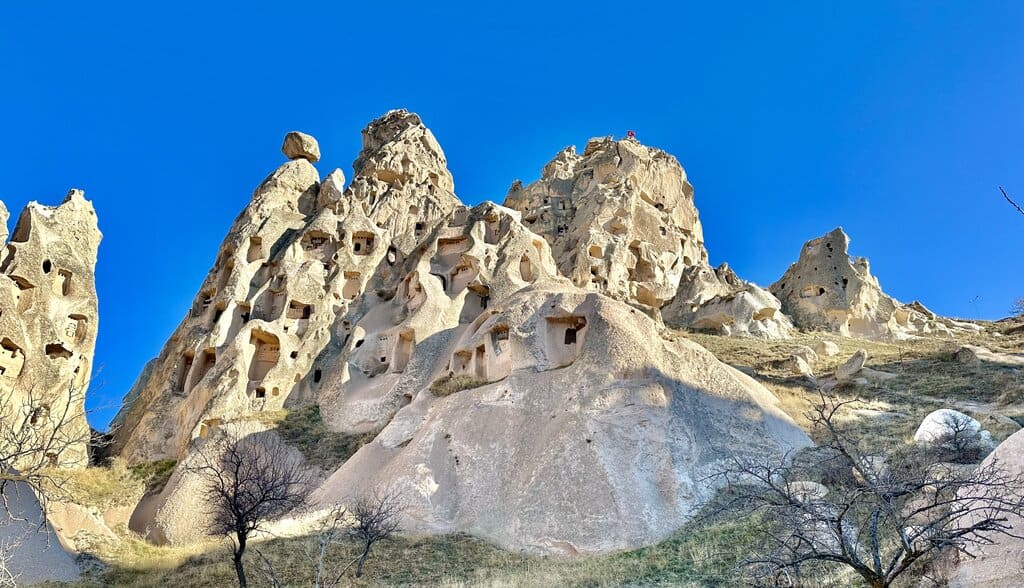
Ortahisar Castle
Ortahisar Castle is similar to Uchisar Castle, just considerably smaller. Entrance is only 10 Lira and there is not too much to see. Great views from the top though.
Kaymakli Underground City
Kaymakli Underground City is the most expansive of Cappadocia’s underground cities. The ancient city of cave homes goes eight stories below ground – though only four stories are open to the public – and features miles of tunnels.
What’s the point of digging a city underground you might ask? Well, mainly to keep out invaders. This region of Turkey has had quite the tumultuous past, and Kaymalki was used through the generations to deter enemies.
The underground city is complete with ventilation shafts, wells, and drainage systems, just like you’d expect for a city built entirely underground. Bedrooms and kitchen and all your typical rooms were simply carved into the soft rock. And it’s not like the people spent all day in their homes. They still had to go outside to tend to their farms and get, you know, like sunlight.
Derinkuyu Underground City
Similar to Kaymalki, Derinkuyu Underground City is another ancient underground city about 10 minutes to the south. The main difference is that Derinkuyu is far deeper than Kaymalki. Extending up to 85 meters (279 feet) below ground, it’s the deepest of Cappadocia’s cave cities.
As a tourist you can get pretty far down – lots of stairs to walk back up – but a sizable portion of the ancient city is not open to tourists.
If you want to experience what it feels like to live underground for a bit be sure not to miss one of these two magnificent underground cave cities!

4) Explore the amazing valleys of Cappadocia
Cappadocia is loaded with scenic valleys, though they’re really more like canyons than valleys. They’re not valleys between mountains, but more like giant cracks in the earth. The best valleys are discussed here.
Pigeon Valley
Pigeon Valley is the shallow valley that runs between Goreme and Uchisar. It gets its name from the swarms of pigeons that found a home in special little pigeon caves that the residents built. It’s not a cave city, but sort of a rural area of cave dwellings. The caves are isolated and you’d figure the people that lived in them wanted their space.
Love Valley
Love Valley is west of Goreme. It gets its name from the large rocks sticking out of the ground of the valley that resemble an important male body part. The valley also features numerous periodically spaced cave dwellings, some so high on the cliff that you wonder how they used to get to their homes. They must have made good ladders!
Red and Rose Valleys
Red Valley and Rose Valley blend into each other on the east side of Goreme. There are endless hiking trails through the valleys and, as usual, ancient cave dwellings here and there.
You can walk into the valleys from Goreme or drive to Red Valley Panorama point and hike into the valley from there. The panorama point is a popular place to watch the sunset over Cappadocia.
5) Ride an ATV or a horse
For whatever reason, ATV rental is huge in Cappadocia. Numerous companies offer sunset ATV rides on the dirt paths through Red Valley and Rose Valley. We didn’t do it ourselves, but people say it’s a great experience.
Another popular activity is horseback riding. Numerous outfitters also offer sunset horseback rides in the various valleys around Goreme.
6) Wine tasting
Cappadocia is one of Turkey’s premier wine-making regions. So if you’re into wine, might as well visit a winery while you’re there. The vineyards themselves are scattered around, but the wineries operate tasting rooms and shops in town.
The top local wines to try are Kocabag and Turasan, whose wines you will see on every restaurant menu in Cappadocia. The Kocabag tasting room is in Uchisar and the Turasan tasting room is in Urgup. Turasan charges a small fee of 50 Lira for tasting three wines, but Kocabag will give you sips of up to six wines for free.
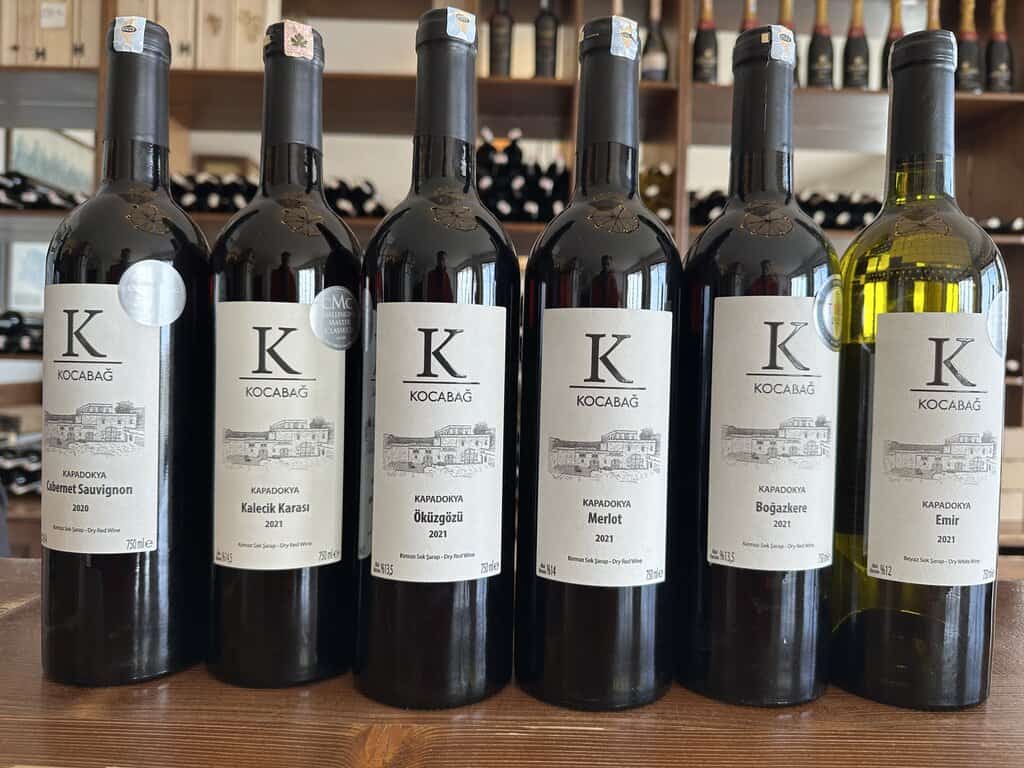
7) Take a winter hike through Cappadocia
Winter in Cappadocia is a great time for hiking so long as the weather cooperates and you don’t catch it on a cold front. The Cappadocia region is home to some fantastic hikes.
Some of the best hikes in the region are:
- Goreme, Love Valley, Uchisar, Pigeon Valley Loop
- Rose and Red Valley Loop
- Full Goreme Loop
- Zemi Valley Loop
- Goreme, Akga, Zelve, Cavusin loop
Cappadocia in Winter – FAQs
Do balloons fly in Cappadocia in winter?
Yes, the balloons fly year round in Cappadocia. The only thing that stops the balloons from flying is weather, specifically wind and fog.
Is a Cappadocia balloon ride worth it?
The worth of something is completely subjective. What I can tell you is that the balloon rides start at about 180 euros for a 1-hour flight. Whether or not that’s worth it is up to you.
Is December a good month to visit Cappadocia?
December is a fine time to visit Cappadocia. It’s cold and the sun sets early, but the start of winter in Cappadocia offers a lot of benefits, as we have discussed in this post.
Is Cappadocia colder than Istanbul?
Yes, in the winter Cappadocia is usually colder than Istanbul. Cappadocia is inland and has an elevation of 3609 ft (1100m), whereas Istanbul is on the coast at sea level.
Why is Cappadocia so special?
Cappadocia is one of the most scenic places in the world due to its unique rock formations and history of cave dwellings. On top of that, the modern phenomenon of the hot air balloon flights over the historic towns is truly a sight to behold.
Final Word
Cappadocia in winter isn’t for everyone. It certainly can get damn cold, and the days sure are short. But to be in one of the most magical places on the planet without the throngs of other tourists is totally worth it.
The lack of crowds brings a sense of peace that can’t be experienced in the hectic summer months. And unlike many other seasonal destinations, everything is still open during wintertime in Cappadocia. I’m sure you won’t be disappointed with your winter visit to Cappadocia!

